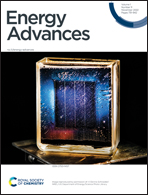Predictive energetic tuning of quinoid O-nucleophiles for the electrochemical capture of carbon dioxide†
Abstract
The need for robust, scalable methods for the capture and storage of carbon dioxide is increasingly pressing. Electric power-based carbon capture methods have drawn attention as a promising strategy due to their potential to couple to renewable energy sources. Materials for the capture of CO2 from air need to overcome the challenges of parasitic reactivity with oxygen, selective removal of CO2 at 415 ppm, and long-term durability in air. Quinones and their reduced forms are a promising family of such sorbents. However, the design of robust quinone sorbents has been limited, and no systematic study exists that unifies the relationship between reduction potential, binding free energy and the effect of CO2 concentration on the average number of CO2 molecules captured. Our work addresses this knowledge gap through a synergistic computational and experimental study of a family of electrochemically generated quinoid molecular sorbents for CO2 capture with tunable redox chemistries. Our findings indicate that while quinones with reduction potentials positive of oxygen reduction exist, the O-nucleophiles generated at these potentials are weak CO2 binders. Using microkinetic analysis to examine binding speciation, we identify sorbent candidates that bind one CO2 molecule within a narrow potential window positive of oxygen reduction. This behavior is calculated to occur at CO2 concentrations relevant to direct air capture. Additionally, while electron-rich quinones are found to generally bind two CO2 units per quinone dianion with little variation across CO2 concentrations relevant to carbon capture, weaker quinones generally exhibit lower stoichiometries and are more sensitive to CO2 concentration. Furthermore, we establish a linear correlation between the second reduction potential of a quinone and the free energy of binding CO2 to the quinone dianion. This correlation has important predictive power, as it allows new molecular materials of the quinoid family to be assessed with simple electrochemical measurements. However, based on our findings, such analyses must be punctuated by careful considerations of reaction stoichiometry and operating concentration ranges.

- This article is part of the themed collections: Carbon capture, storage or utilisation – Topic Highlight and Energy Advances – 2022 Outstanding Papers


 Please wait while we load your content...
Please wait while we load your content...